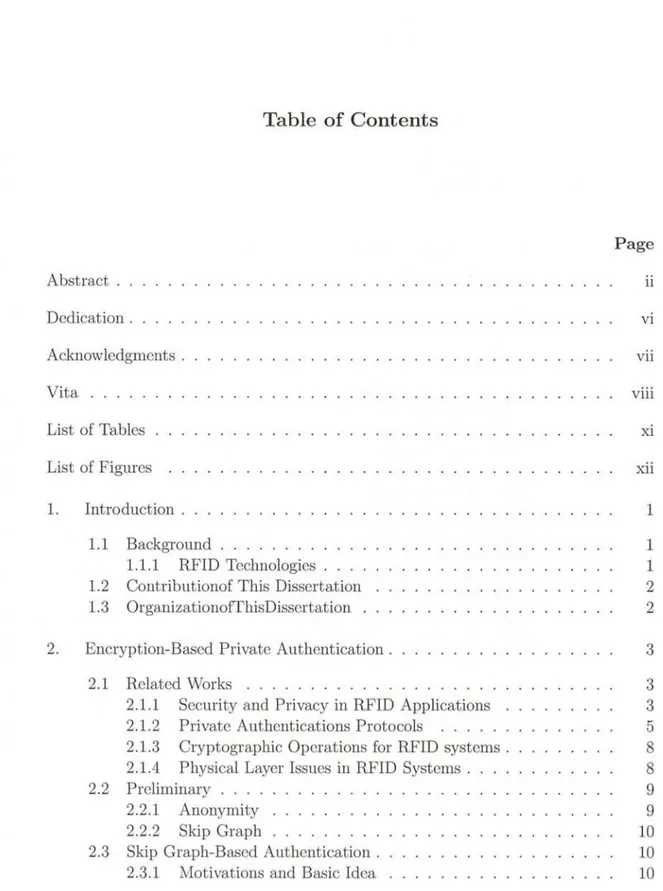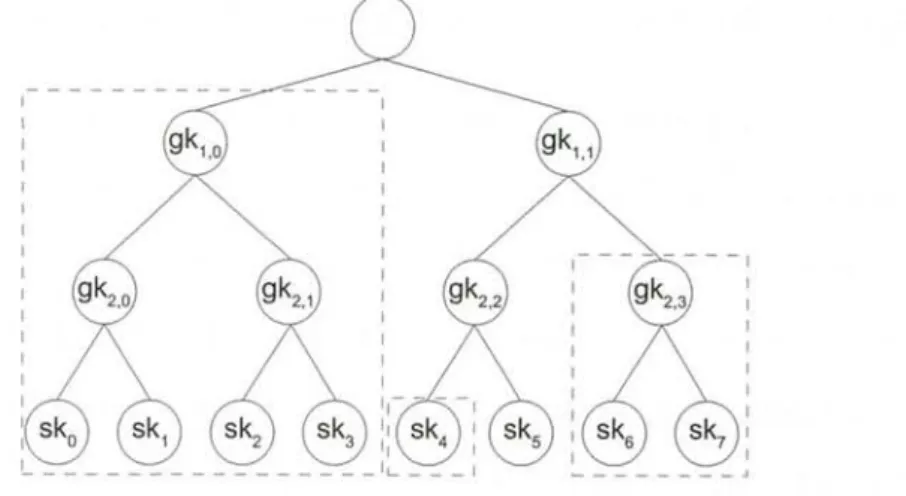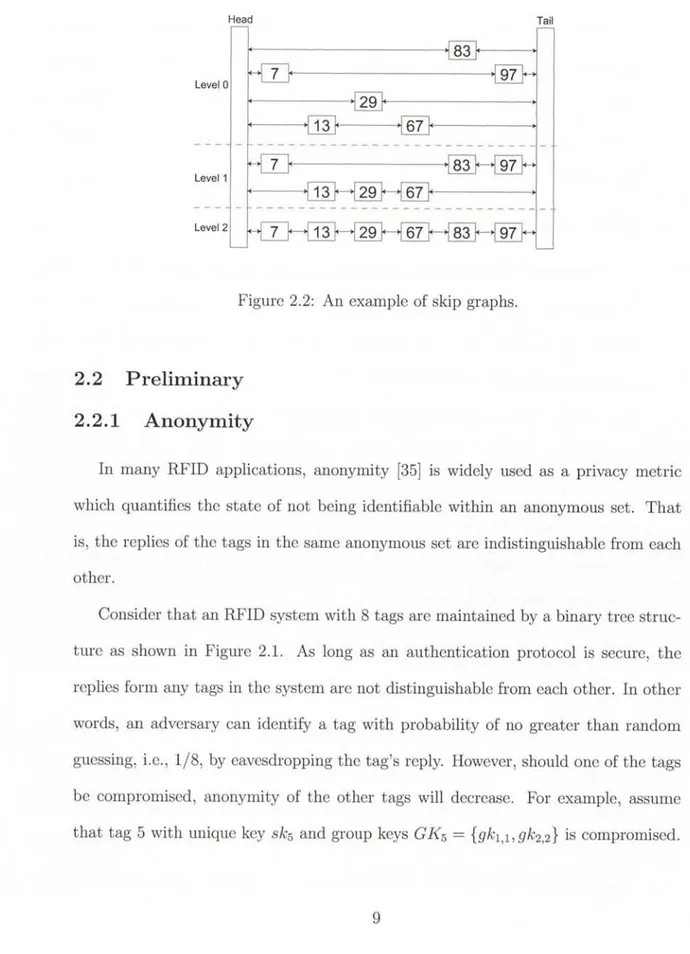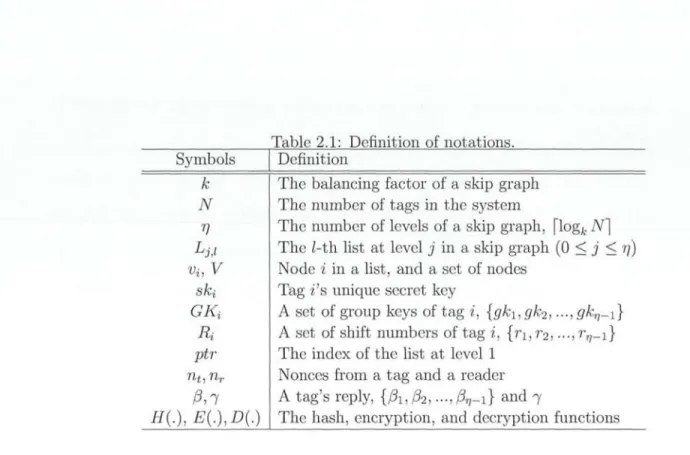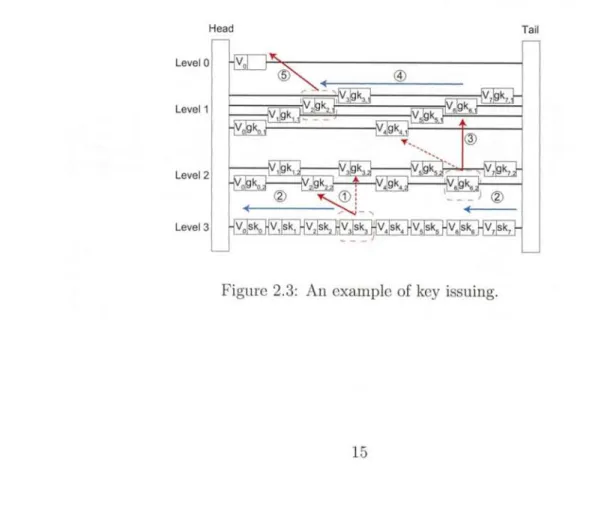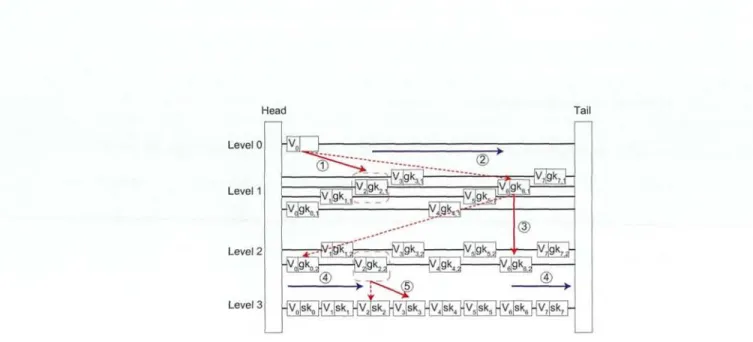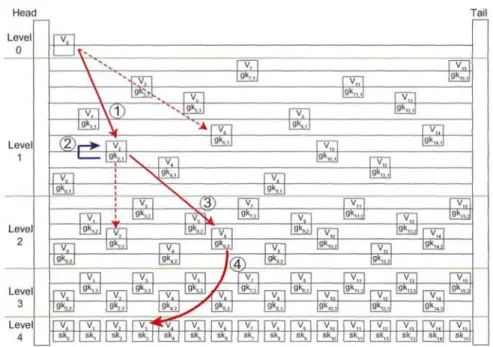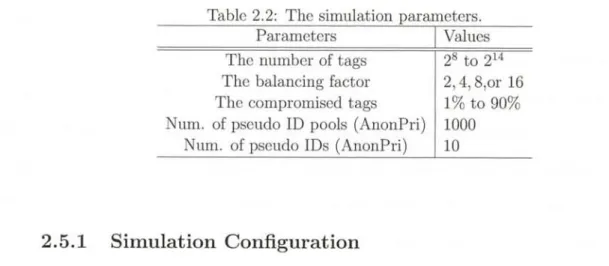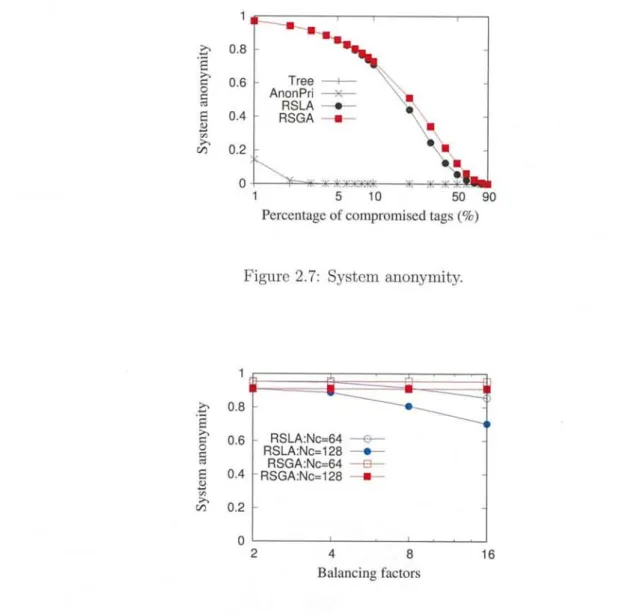Improving Security and Privacy in Large-Scale RFID Systems
Dissertation
Presented in Partial Fulfillment of the Requirements for the Degree Master of Engineering in the Graduate School of The Tokyo
Metropolitan University
By
Yudai Komori, B.S.
Graduate Program in Department of Information and Communication Systems
The Tokyo Metropolitan University
2018
Dissertation Committee:
Satoshi Fukumoto, Advisor Kazuhiko Iwasa.ki Kiyoshi Nishikawa
© Copyright by Yudai Komori
2018
Abstract
Radio Frequency Identification (RFID) technologies lay in the very heart of In- ternet of Things (IoT), in which every physical objects are tagged and identified in an internet-like structure. High performance and privacy-preserving interrogations of individual tags, generally called private tag authentication, is crucial for effective monitoring and management of a large number of objects with RFID tags. An RFID system consists of RF readers and RF tags. RF tags are attached to objects, and used as a unique identifier of the objects. RFID technologies enable a number of business and personal applications, and smooth the way for physical transactions in the real world, such as supply chain management, transportation payment, animal identification, warehouse operations, and more. Though bringing great productivity gains, RFID systems may cause new security and privacy threats to individuals or or- ganizations, which have become a major obstacle for their wide adaptions. Therefore, it is important to address the security and privacy issues in RFID systems.
In this dissertation, we investigate two important security and privacy issues for large-scale RFID systems.
First, we discuss the private tag authentication problems. In a singulation pro- cess, an RF reader first sends a query and energizes an RF tag, and then the tag replies its ID or data to the reader. As the tag's ID itself is sensitive information, the reply from tags must be protected against various threats, such as eavesdropping
ii
and compromise attacks, where tags are physically tampered and the keys associated with compromised tags are disclosed to adversaries. Fast and secure object identi- fication, generally called private tag authentication, is critical to efficiently monitor and manage a large number of objects with Radio Frequency Identification (RFID) technologies. In a singulation process, an RF reader queries an RF tag, and then the tag replies its ID or data to the reader. Since the tags ID itself is private information, the reply must be protected against various threats, such as eavesdropping and com- promised attacks, where tags are physically tampered and the keys associated with compromised tags are disclosed to adversaries. Hence a large amount of efforts have been made to protect tags replies with low-cost operations, e.g., the XOR operation and 16-bit pseudo random functions (PRFs). In the primitive solution, a tag sends a hashed ID, instead of its real ID, to a reader, and then, the reader searches the corresponding entry in the back-end server. While this approach defends tags replies against various attacks, the authentication speed is of 0(N), where N is the number of tags in the system. Hence, such a straightforward approach is not practical for large-scale RFID systems. In order to efficiently and securely read tags content, pri- vate authentication protocols with structured key management have been proposed.
In these schemes, each tag has its unique key and a set of groups keys. Groups keys are shared by several tags and used to confine the search space of a unique key. With efficient data structures, the tag authentication completes within 0(log k N). How- ever, private authentication protocols with structured key management unfortunately reduce the degree of privacy, should some tags in the system be compromised. This is because group keys are shared by several tags, and physical tampering of some tags makes the other tags less anonymous. How to remedy this issue is equivalent
to reducing the probability that two tags share common group keys (hence after we refer to it as the correlation probability). The introduction of random walking over a data structure, e.g., randomized tree-walking and randomized skip-lists, significantly reduces the correlation probability. Nevertheless, two tags are still correlated should they have same groups keys at all the levels of in a balanced tree or skip lists. In our study, we design a private tag authentication protocol, namely Randomized Skip Graphs-Based Authentication (RSGA), in which unique and group keys are main- tained with a skip graph. The RSGA achieves lower correlation probability than the existing scheme while maintaining the same authentication speed as the tree struc- ture.
Second, we discuss the fast and secure grouping problems. In the large-scale RFID systems, categorization and grouping of individual items with RF tags are critical for efficient object monitoring and management. For example, when tags belonging to the same group share a common group ID, the reader can transmit the same data simultaneously to the group ID, and it is possible to save considerably the communication overhead as compared with the conventional unicast transmission. To this end, Liu et al. recently propose a set of tag grouping protocols, which enables multicast-like communications for simultaneous data access and distribution to the tags in the same group. In the reality, not only the performance issue, but also security and privacy-preserving mechanisms in RFID protocols are important for protecting the assets of individuals and organizations. Although a number of works have been done for protecting tag's privacy, to the best of our knowledge, the problem of private tag grouping is yet to be addressed.
iv
To address the problem of private tag grouping in a large-scale RFID system, we first formulate the problem of private tag grouping and define the privacy model based on the random oracle model. As a baseline protocol, we design a private traditional
polling grouping (PrivTPG) protocol based on traditional tag polling protocol. Since PrivTPG is a straightforward approach, it can take a long time. Hence, based on the idea of broadcasting group IDs, we propose a private enhanced polling grouping (PrivEPG) protocol. To further improve the efficiency of tag grouping, we propose a private Bloom filter-based grouping (PrivBFG) protocol. These protocols broadcast unencrypted group IDs. Therefore, we propose a private Cuckoo filter-based polling grouping (PrivCFG) protocol, which is a more secure protocol using a data structure called a cuckoo filter.Then, the protocol-level tag's privacy of the proposed PrivTPG, PrivEPG, PrivBFG, and PrivCFG is proven by random oracles. In addition, com- puter simulations are conducted to evaluate the efficiency of the proposed protocols with different configurations.
This is dedicated to my family for their love, support, and trust.
vi
Acknowledgments
It would have been impossible for me to finish my M.S study without the support, help and guidance I have received from the professors, colleagues, friends, and my family.
I would like to thank my advisor, Professor Satoshi Fukumoto for useful discus- sions. I wish to thank Professor Kazuya Sakai. I learned form him not only how to conduct top-level research work, but also how to improve myself in every aspect. He is one of the smartest people that I have met in my life.
I am also grateful to laboratory members. Thanks to them, my student life has become very fulfilling.
There were great helps from people outside of The Tokyo Metropolitan University.
I would like to express my gratitude to Professor Masayuki Arai at The Nihon Univer- sity and Professor Mamoru Ohara at The Tokyo Metropolitan Industrial Technology Research Institute for their help for my research.
vii
Vita
July 12, 1993 ...Born - Saitama, JPN 2015 ...B.S. Engineering
Publications
Research Publications
Y. Komori, K. Sakai, S. Fukumoto "Randomized Skip Graph-Based Authentication for Large-Scale RFID Systems". WASA, Vol. 9798, 2016, pp. 112
Y. Komori, K. Sakai, S. Fukumoto "RFID Tag Grouping Protocols Made Private".
DSN, June 2017
Y. Komori, K. Sakai, S. Fukumoto "Fast and secure tag authentication in large-scale RFID systems using skip graphs". Computer Communications, Vol. 116, January 2018, pp. 7789
Fields of Study
Major Field: Department of
Information and Communication Systems
Viii
Table of Contents
Page
Abstract ... ii
Dedication ... vi
Acknowledgments ...
Vita ...
vii
viii
List of Tables ... xi
List of Figures ... xii
1. Introduction ...
1.1 Background ...
1.1.1 RFID Technologies . . . 1.2 Contributionof This Dissertation 1.3 GrganizationofThisDissertation .
1 1 1 2 2
2. Encryption-Based Private Authentication ...
2.1 Related Works ...
2.1.1 Security and Privacy in RFID Applications ...
2.1.2 Private Authentications Protocols ...
2.1.3 Cryptographic Operations for RFID systems ...
2.1.4 Physical Layer Issues in RFID Systems ...
2.2 Preliminary ...
2.2.1 Anonymity ...
2.2.2 Skip Graph ...
2.3 Skip Graph-Based Authentication ...
2.3.1 Motivations and Basic Idea ...
3 3 3 5 8 8 9 9 10 10 10 ix
2.3.2 Definitions and Assumptions ...
2.3.3 The Proposed Authentication Protocol ...
2.3.4 Key Updating Algorithm ...
2.3.5 Path Pruning ...
2.4 Analyses ...
2.4.1 Anonymity Analysis ...
2.4.2 The Comparisons with The Existing Solution . . 2.4.3 The Storage Analysis ...
2.4.4 Weight Analysis ...
2.5 Performance Evaluation ...
2.5.1 Simulation Configuration ...
2.5.2 Simulation Results of Static Systems ...
2.5.3 Simulation Results of Dynamic Systems ...
12 13 20 22 25 25 26 27 28 28 29 30 34
3. Grouping Protocols ... 37
3.1 3.2
3.3
3.4
3.5 3.6
Related Works ...
Preliminary ...
3.2.1 The Tag Grouping Problem 3.2.2 Grouping Protocols ...
3.2.3 Bloom Filters ...
3.2.4 Cuckoo Filter ...
The Privacy Model ...
3.3.1 Privacy Model ...
3.3.2 The Limitation of Our Mod Private Grouping Protocols . . . 3.4.1
3.4.2 3.4.3 3.4.4 3.4.5 3.4.6
...
...
el ...
...
Motivations and Basic Idea ...
System Parameters . . The Private TPG Protocol The Private EPG Protocol The Private BFG Protocol The Private CFG Protocol Analyses ...
Performance Evaluation ...
3.6.1 Simulation Configuration ...
3.6.2 Simulation Results ...
37 38 38 38 39 39 40 40 42 43 43 43 44 45 46 49 52 54 54 55
4. Conclusion ... 59
Biblio graphy ... 61
List of Tables
Table
2.1 Definition of notations. . . . 2.2 The simulation parameters.
3.1 The simulation parameters.
Page
12
29
55
xi
List of Figures
Figure
2.1 An example of tree-based protocols.
2.2 An example of skip graphs. ...
2.3 An example of key issuing...
2.4 The corresponding set of trees. . 2.5 An example of authentication. . . . 2.6 An example of the path pruning. . 2.7 System anonymity. ...
2.8 System anonymity for different k. . 2.9 System anonymity for different k.
2.10 Authentication speed. ...
2.11 Storage cost. ...
2.12 System anonymity. ...
2.13 System anonymity for different k. . 2.14 System anonymity for different k.
3.1 The state diagram of PrivTPG. . .
•
•
•
•
•
•
•
•
•
•
•
•
•
•
•
•
•
•
•
•
•
•
•
•
•
•
•
•
•
•
•
•
•
•
•
•
•
•
•
•
•
•
•
•
•
•
•
•
•
•
•
•
•
•
•
•
•
•
•
•
•
•
•
•
•
•
•
•
•
•
•
•
•
•
•
•
•
•
•
•
•
Page
. 7
. 9
. 15
. 16
. 18
. 24
. 31
. 31
. 32
. 33
. 35
. 35
. 36
. 36
. 44
3.2 3.3 3.4 3.5 3.6 3.7 3.8 3.9
The state diagram of PrivEPG. ...
The state diagram of PrivBFG. ...
The state diagram of PrivCFG. ...
Amortized space cost per item vs. measured false positive rate . . . The execution time of different protocols...
The execution time for different number of groups. ...
The execution time for different means of the group size. ...
The execution time for different standard variance of the group size.
46
49
51
53
55
56
56
57
xiii
Chapter 1: Introduction
1.1 Background
Radio Frequency Identification (RFID) technologies lay in the very heart of Inter- net of Things (IoT), in which every physical objects are tagged and identified in an internet-like structure. An RFID system consists of RF readers and RF tags. An RF tag is attached to an object and used as the unique identifier of the object. RFID sys- tems smooth the way of various physical transactions (ex. distribution management, supermarket, public transport, etc...) in the real world.
1.1.1 RFID Technologies
The RFID system consists of an RF tag, an RF reader, and a back-end server.
Communications between RF reader and backend server uses encryption method as used for the existing Internet, so we will not discuss it in this paper. RF tags are classified either active or passiv. Active tags have a transmission module and a battery for data transmissions. On the other hand, passive tags do not have a power source, and have very weak calculation power. However, since passive tags are very inexpensive, mass production is possible. Hence, most RFID applications employ passive tags, in this dissertation, we consider RFID systems with passive tags.
I
1.2 Contributionof This Dissertation
In this dissertation, we propose solutions to private tag authentication and dgroup- ing problems. The contributions of each chapter in this dissertation are as follows:
• Contributions of Chapter 2
1. We design a new encryption-based private authentication protocol based on skip graph. Unlike the existing solutions, the proposed protocol provides
strong privacy protection in keeping with high performance.
2. We quantitatively and qualitatively analyze the new authentication proto- col based on skip graph.
• Contributions of Chapter 3
1. We introduce the grouping problem and fast grouping protocols.
2. We address the private tag grouping at the protocol-level, where for a given tag an adversary cannot identify the tags group.
3. We design four private grouping protocols.
1.3 OrganizationofThisDissertation
The rest of the dissertation is organized as follows. In Chapter 2, we propose a new encryption-based private authentication, called Randomized Skip Graph-Based Authentication (RSGA). In Chapter 3, we study the secure grouping protocols and de- sign private grouping protocols, namely PrivTPG, PrivEPG, PrivBFG, and PrivCFG.
We conclude this dissertation in Chapter 5.
Chapter 2: Encryption-Based Private Authentication
2.1 Related Works
2.1.1 Security and Privacy in RFID Applications
In all the RFID systems, an RF reader identifies individual tags by an Aloha-
based or tree-waking-based query-and-response [25]. The signal from the reader to
tags is called the forward channel; the signal from the tags to the reader is called the backward channel. Defending the forward channel is relatively easy, since the queries
form a reader can be easily randomized [37]. On the other hand, designing backward channel protection mechanisms is non trivial work due to the computational weakness of RF tags.
Different RFID applications require different types of the backward channel pro- tection mechanisms. For example, Czeskis et al. [8] develop a motion signature to counteract a man-in-the-middle variant, so-called the ghost-and-leech. Saxena et al. [34] introduce tag activation, where a tag would not reply to a reader's query until it is unlocked by the smartphone of the tag's owner. Sakai et al. [30, 32] design jamming-based backward channel protection mechanism with bit encoding schemes.
One of the advantages of their schemes is that no shared secret is required before interrogations. This can be achieved by the jamming-based technique, called privacy
3
masking [6]. For example, when a tag sends a 4-bit string, say 1001, the reader (or a trusted masking device) simultaneously sends a mask, say 1011. Under the assump- tion of the additive channel, the reader and/or an eavesdropper receives 10X1, where X denotes a corrupted bit. From the received bits 10X1, the legitimate reader with the mask information can recover the original bit string from the information about the mask bits. On the other hand, an eavesdropper without the mask information cannot recover the original bit string. By doing this, a tag can securely transmit a bit string to the reader as long as at least one bit is corrupted. Based on this idea, randomiza- tion and encoding schemes are incorporated in [30]. The protocol in [32] also relies on jamming-based environment, but works on weaker physical layer assumptions in the sense that the jamming model relies on the existing physical layer technologies.
While these security mechanisms aim to protect RF tag embedded smart cards or de- vices, they cannot be applied to large-scale R,FID systems. This is because bit-by-bit operations as well as additional devices for privacy masking are required, which are too expensive to manage a number of objects with tags. In fact, to securely identify a tag, each bit must be encoded into a codeword with length being longer than or equal to 4-bit, i.e., the communication cost increases by at least four times. Then, the each codeword must be masked by privacy masking or jamming. In addition, all the aforementioned authentication schemes assume that no tag is physically tampered.
Secure grouping protocols are proposed in [17], which ensure the indistinguish- ablies among tag's IDs and groups. In [5], a generic framework for detecting various anomalies and attacks, such as missing tags due to theft, cloned tags, targeted attacks, and so on. As a privacy preserving RFID protocol, a key-tag tracking algorithm to es- timate the number of a small set of key tags among all the tags in the system without
disclosing tag's IDs in [20]. However, none of [17, 5, 20] provides any authentication
mechanism. The most related works to this paper is the private tag authentication protocol design for the object management in large-scale RFID systems, which is elaborated on the next subsection.
2.1.2 Private Authentications Protocols
To protect the backward channel, or tag's replies, a number of authentication protocols with light-weight cryptographic operations have been proposed in the past.
Weis proposes Hash-lock [36], where a tag computes a hashed ID using its unique key,
and then, replies the hash to a reader. The reader communicates back-end server for searching the pair of the tag's ID and unique key corresponding to the tag's reply.
The reader must search all the pairs of a tag ID and a unique key, which causes authentication to take a long time. This motivates private authentication to have structured key management.
Private authentication protocols with structured key management [14, 29, 24, 21, 38, 31, 35] use one unique key and a set of group keys. A tag's reply contains a
set of hash values each of which is computed using the unique key and one of group keys. In the authentication phase, A reader first scans the group keys to confine the search space of the unique key. As shown in Figure 2.1, the tree-based authentication
schemes [24, 21] use a balanced tree for the key management. The tags in the system are located at leaf nodes in the tree. Each tag obtains the unique key, denoted by sk, from its leaf node and the set of group keys, denoted by gk, at the non-leaf nodes on the path to the root. Starting from the root, the reader identifies a tag by traveling
5
the tree toward the corresponding leaf node. Hence, authentication speed of the tree-
based protocols is O(logk N), where N is the number of tags and k is the balancing
factor of the tree. However, should some tags be compromised and group keys be correlated, the system anonymity significantly decreases.
Improving anonymity is equivalent to making the correlation probability as small
as possible. To this end, Lu et al. [22] use a sparse tree, where the number of non-leaf
nodes are much larger than the number of tags. However, this approach increases
the height of a tree causing to unacceptable storage cost to tags. Sun et al. [35]
incorporates the idea of random walking over a skip list, which is a probabilistic tree- like structure consisted of a set of lists. By taking random shift at each level of skip lists and incorporating the dependency among levels, two tags are never linked unless they have exactly the same set of group keys.
There exists a faster authentication protocol, e.g., ETAP [3] and its extended version [4], which runs in 0(1) by mapping hashed IDs and real IDs using a hash index. Their claim relies on that the random access of a hash index provides the 0(1)
access. However, this is the average performance, and hash-based protocols may take
0(n) in the worst case. Hence, this direction is out of our scope.
Recently, some mutual authentication protocols for application-specific context
have been proposed. In [23], Luo et al. propose Succinct and Lightweight Authen- tication Protocol (SLAP) as an ultralight RF1D protocol, which does not require for tags to implement any pseudorandom function generator. While such a class of pro- tocols is desirable for the RFID systems with low-cost tags, according to the EPC Global standard [101, tags may implement a random or pseudorandom number gener-
ator. Thus, we may still rely on the assumption of the availability of pseudorandom
gkz,o gk1
gk2.1 9k2,2
gk1 ,1
gk2,3
Figure 2.1: An example of tree-based protocols.
generators for protocol designs. The protocol proposed in [12] is primarily designed for healthcare applications. Farash et al. [12] improve the existing solution [40] in
terms of the forward security and untraceability by applying Ecliptic curves to the RFID mutual authentication. However, computing the public key operations incurs
heavy burden for tags. In [13], Gope et al. study a lightweight authentication pro-
tocol for distributed IoT applications in smart city. Their protocol not only protects the forward security, anonymity, and tag access traces, but also the location of RFID-
embedded objects/devices. The works [12, 40, 13] ensure the security and privacy in application-specific environments such as medical systems and IoT applications. In contrast, our study focuses on the RFID-based large-scale object management, e.g., inventory management, RFID library, etc., using data structures for key management.
7
2.1.3 Cryptographic Operations for RFID systems
Since RF tags are computationally weak devices, only lightweight cryptographic
operations are feasible at tags. According to the EPC standard [10], the 16-bit pseudo-
random number generator shall be implemented in all passive RF tags. To this end,
Poschmann et al. developes Data Encryption Standard Lightweight (DESL) [27],
which requires only 1,848 gates. Using a DES type s-box and the XOR operations, a
lightweight short hash function is proposed by Jappinen et al. in [15]. A pseudoran-
dom function can be implemented with the aforementioned low-cost operations by an
8-bit shift register with an XOR feedback loop [39].
2.1.4 Physical Layer Issues in RFID Systems
EPC Global Gen 2 standard operates in the 860 MHz - 960 MHz UIIF range, and the IS018000-4 standard operates in the 2.4GIIr ISM band. The chennel conditions
by an RFID system significantly affect the performance of RFID protocols, which can be modeled by the product of distance-dependent average path loss law, variation in the local mean power (shadow fading), and small-scale fading. In [33], an additive
model for shadow fading is proposed. Path loss and multipath propagation character-
istics are studied in the UHF band in [26]. In [7], the characterization of large-scale
fading is investigated in an obstacle-dense environment, a shadow depth calculation method is invented.
Since the focus of this paper is on the protocol-level security in RFID systems, a reader and tags are assumed to be able to communicate each other without frame-level errors. Therefore, the impact of channel conditions is out of our scope.
Level 0
Level 1
Level 2
Head Tail
0
1
2
'183~
H 7 ,197H
H29
'167[4
i8314~97H
7
29 .67.
H 7 },---*13H29 4)16714 83 ,197H
Figure 2.2: An example of skip graphs.
2.2 Preliminary 2.2.1 Anonymity
In many RFID applications, anonymity {35j is widely used as a privacy metric which quantifies the state of not being identifiable within an anonymous set. That is, the replies of the tags in the same anonymous set are indistinguishable from each other.
Consider that an RFID system with 8 tags are maintained by a binary tree struc- ture as shown in Figure 2.1. As long as an authentication protocol is secure, the replies form any tags in the system are not distinguishable from each other. In other words, an adversary can identify a tag with probability of no greater than random guessing, i.e., 1/8, by eavesdropping the tag's reply. However, should one of the tags be compromised, anonymity of the other tags will decrease. For example, assume that tag 5 with unique key sk5 and group keys GK5 = {gk1,1, gk2,2} is compromised.
9
Then, the replies from the other tags will be partially disclosed from the keys associ- ated with tag 5. As a result, an adversary can divide the uncompromised tags into 3
disjoint sets, i.e., {0, 1, 2, 3}, {4}, and {6, 7}. These tags are anonymous within one of three sets, and thus, the adversary can identify them with probability of either 1, 0.5, or 0.25.
2.2.2 Skip Graph
A skip graph {11 is a probabilistic data structure, which has the full functionality
of a balanced tree and consists of a set of ordered doubly linked lists as shown in Figure 2.2. In other words, a skip graph can be seen as a set of trees. Each level,
except the lowest level (labeled by level 2), has one or more lists, and the lowest level has one list containing all the nodes. Every node participates to one of the lists at each level. A node in the list at level i for i > 0 appears at level i —1 with probability of 1/k, where k is the balancing factor. Given the number of inputs N, the number of levels, denoted by 1 , is defined as 77 = [logk Ni, Thus, there are lists at level j on average. The operations of search, insert, and delete are performed in O(logk N).
The space complexity is O(N log N).
2.3 Skip Graph-Based Authentication 2.3.1 Motivations and Basic Idea
To the best of our knowledge, the use of random walking over a data structure, e.g., RSLA [353, achieves the highest degree of privacy among the existing works.
In this approach, the correlation probability depends on the number of levels and the number of internal nodes at each level. In the tree-based and skip lists-based protocols, the number of levels is defined as 71 = [log, Ni. The number of nodes
at level i is defined as ki. Hence, the correlation probability can be obtained by 11rbbgk i=1kx Ni-1 I
One naive approach to decrease the correlation probability is the use of sparse
structures [22j, i.e., the internal nodes in a data structure is much larger than the number of tags. However, introducing redundant internal nodes is undesirable. The number of group keys that each tag stores increases in proportion to the number of levels of a data structure. In general, the passive tag has 512-bit memory, and the length of a tag's ID is 96 bits. Assuming that the length of a unique key and a group key is 32 bits, the number of levels can be at most 13, (which can be derived by (512 — 96)/32 = 13. The number of tags which can be supported by this approach is much smaller than 213 when the structure is sparse. Therefore, increasing the number of levels of a key structure is not practical for large-scale RFID systems.
To tackle this issue, we propose Randomized Skip Graph-based Authentication (RSGA), which runs in D(logk N). The overview of the proposed RSGA is as follows.
First, a skip graph with ri + 1 levels is deterministically constructed in which unique keys are located at the nodes in the list at level r1 and the group keys are located at
the nodes in the list at level j (1 C j C — 1). Then, each tag is associated with a node of the lowest level list. Starting from the bottom, a tag obtains the unique key and a set of group keys along the path toward the top level list. At each level, random shifting is performed (hence, the protocal is randomized). In the singulation
process, the reader will find the node corespoinding to a tag's reply in the lowest
list by trveling from the top. The proposed RSGA differs from RSLA [35] in the
initialization, key issuing, private authentication phases, and key updating. For the
11
Table 2.1: Definition of notations.
Symbols Definition
k N
vi, V
ski
ptr nt, nr
( ), E(•), D(•)
The balancing factor of a skip graph The number of tags in the system
The number of levels of a skip graph, [Iogk Ni The 1-th list at level j in a skip graph (0 C j < 77)
Node i in a list, and a set of nodes Tag i's unique secret key
A set of group keys of tag i, {gki, gk2i ..., gk t_1 } A set of shift numbers of tag i, {r1i r2, ..., rn_1}
The index of the list at level 1 Nonces from a tag and a reader A tag's reply, 1/31, (32 i ..., ~3,t_z}and 'y
The hash, encryption, and decryption functions
system maintenance, the similar approaches in [21
phase is elaborated on in the subsequent sections.
2.3.2 Definitions and Assumptions
, 35) can be applied to RSGA. Each
We assume that an RFID system consists of N tags and one reader, which is connected to the back-end server. In addition, the reader and back-end server are as- sumed to be connected via a secure channel. Hence, the reader is the final destination of all the tags.
The nonces are randomly selected by the reader and a tag, which are denoted by n, and nt, respectively. The hash function H(.) is assumed to be collision resistant, and an encryption function E(.) is implemented by low-cost cryptographic operations [36].
In addition, the pseudo random family (PRF) is defined as F(.) which returns a 96
bits value. We assume that RF reader has enough computational power to run a decryption function DO. ) . The symbols used in this paper is listed in Table 2.1.
2.3.3 The Proposed Authentication Protocol Construction of A Skip Graph
Given the number of tags N and the balancing factor k, a skip graph with + 1 levels is generated, where 7/ is defined as [logk Ni. There exits one list in the lowest level, which contains all the nodes, so that every tag can be allocated. At level j (1 < j < --- 1), there are kri-i lists and each of them contains /0 ; nodes. To form a list, node vi has pointers to the right and left nodes in the same list at level j , which arc denoted by vi.right[j] and vi.le f t[j]. The left pointer of the head node and the right pointer of the tail in the list are null. Let L/be the 1-th list at the j-th level from the top. For all the level, node vi belongs to list Li,z, where I is computed by i mod ki7-3. The level 0 has one list which contains node vp, and this is used as the entry point for key searching.
Each node has a key for each level. Let vi . key [ j ] be the variable to store a key at node vi. To be specific, vi,key[q] contains unique key ski and vi.key[j] (1 C j C r - 1) contains group key gkij. No key is assigned to the node in level 0 list. Thus, vo.key[0]
is empty.
Since the construction of a skip graph is deterministic, our skip graph with the balancing factor k works in the same fashion to a set of k-balanced trees with the nodes in the lower levels belonging to more than one tree. For example , Figure 2.3 shows a skip graph with N = 8 and k = 2. The corresponding set of binary trees are shown in Figure 2.4.
13
Algorithm 1 KeyIssue()
1:
2:
3:
4:
5:
6:
7:
8:
9:
10:
11:
12:
13:
14:
15:
16:
17:
18:
19:
20:
21:
22:
23:
24:
25:
26:
/* Key Issuer does following */
Issuer locates all tags t to node vi
/* For each tag t, Key Issuer does following */
for each tag t in the system do
Keylssue(t, vi)
/* The function to assign keys to tag t */
Keylssue(t, vi)
/* vi is the current node */
Rt= I* Initialize the random shift numbers list */
Gift /* Initialize the group keys list */
~ * At the lowest level list 4,0 */
skt vi . key [r]]
/* A parent is randomly chosen among k — 1 nodes */
nuniform [O,k — 1]
vi vp where p = (i — nk't-j ) mod N for (j from 77 — 1 to 1) do
/* Random shifting by r and add a group key */
rrinifarm. {O,I Lj1 - 11 t Add rtoR#
v~-shift to the left by r Add vi.key[j] to GK1 I* Move to upper level */
rZ ;---urcifarm[0, k — 1]
vi+-vp where p = (i — nk't^1 ) mod N j4-j-1
ptr 4— vi
Key Issuing
In RSGA, every tag has four variables, the unique key ski, a set of group keys CKt, a set of random shift numbers Rt, and list index ptr. Tag t is located at one
of the nodes, say vi, in the list at level r~, and the unique key at vi.key[7q]is assigned
to tag t. A set of group keys are assigned to tag t by traveling with random shifting from vi at level 77 to the top of the skip graph. At level j, node vi has a set of parents,
denoted by Vd , since there are more than one lists at level j (1 C j C rr - 1). Here, V,3 includes k nodes, vp for p = (i - nl l-i) mod N (0 C n C k -- 1). The key issuer randomly selects one of the node in Vd and moves to the upper list 4 _1,1 to which node v, belongs at level j - 1. Then, random number ri E [0, N - 1] is generated and the left shift by ri is taken. If the pointer reaches to the head node in the list, it moves to the tail. The value of r, is added to Rt for the j-th level. The pointer is now at a node, say u , at level j 1. The group key at v .key[j -1] is added to GKt. This
process repeated until the pointer reaches at the top list. Unlike a tree and skip lists, there are more than one node at level 1. Thus, the entry point of the skip graph, i.e., the ID of list L1 ,1 at level 1, is kept in ptr. At the end of this process, tag t has one unique key, rr - 1 group keys, rr - 1 shift number, and ptr. The pseudocode of key issuing is presented in Algorithm 1.
Level 0
Level I
Level 2
Level 3 I-lead
vo
Tail
k iV31gk3.1
1 11 - - - Vslgk V_ck_]{V'k'
Volg ko .0k4
30k3 kr
Q jV7 gk,
nigkn k <~gka
_ _ ) 2~
Vo sko fiV, ski f1Vx~sk2 liV3~sk3IVV4sk,~V5sk5~VssksVsk7
Figure 2.3: An example of key issuing.
15
Example Figure 2.3 illustrates a skip graph key structure with k = 2 and ri = 3 of an RFID system with 8 tags. All tags are located at one of the nodes in the lowest level list L3,1. The key issuer assigns group keys and random shift numbers to a tag, say tag 3, by traveling the skip graph starting from v3 in L3,1 to the root as follows.
First, unique key sk3 at v3.key[3j is assigned to tag 3. According to Figure 2.3, v3 has
two parents nodes v2 and v3 at level 2. Assume that the key issuer randomly selects r2 = 2 and the random shift number is added to R3. The current pointer shifts to the left by 2 and will be at v6 in L2. Next, tag 3 obtains group key gk6 ,2 stored in
v6. key[2] . This process is repeated until the pointer reaches L0. Assume that the key issuer selects a parent node v6 at level 1 and tag 3 selects r1 = 1 at level 1. At last, v2 (the head node in the list to which v6 belongs in level 1) is stored at ptr as the entry point to the skip graph. Eventually, tag 3 obtains sk3a {gk2,1, gk6,2}, R3={1,2}, and ptr=v2.
( root
(a) Tree 1 (root_.)
(c) Tree 3.
Figure 2.4:
root
The corresponding set
(b) Tree 2.
root:)
(d) Tree 4, of trees.
Mutual Authentication
After issuing keys, the reader can securely communicate with tags. In the RSGA authentication protocol, the reader first sends a query with nonce nr, then a tag generates a reply with nonce nt and sends the reply. The reader receives and decrypts the tag's reply.
The replying process at the tag's side is as follow. Assume tag t has the unique
key ski, a set of group keys GK = {gk1, gk2, ..., gk,t_1 }, a set of random shift numbers Rt = {Pi, r2, ..., r,1_1}, and the pointer ptr. When tag t receives a query with nonce nr
from the reader, tag t generates a reply message with nonce nt. The reply message is
defined by ptr, /3 — {01, ^82, .,.,i,t-1}, and 'y. The value of f3j consists of a hash value 83i.hash and encrypted shift number, i.e., /3i = (,3i.hash, /3j.num), where 8.jhash = H(gk~~~ra-1 IntI Inr) and /3 .num = E(gk3I Irj).
At level 1, j31.hash is computed with the base r0 = ptr. The reason why the shift number is included at the previous level is to enforce dependency among the levels to preserve high anonymity. The random shift number rjis encrypted by E (gk3 Ilrj ) and set to f;.num. While each component of [3 is computed using a group key at each level i, and 7 is computed using a unique key at level r1. The value of 7 is obtained by IDt F(01 skt f J r~7_ 1 [ [nt [ Inr), where IDt is the ID of a tag and R.) is the PRF.
As the input of F(.), 0 is concatenated with other parameters for the purpose of the mutual authentication. Finally, tag t sends nt, C3, 7, and ptr to the reader. Note that /9 contains rl — 1 elements. The pseudocode of the tag's reply is provided in Algorithm 2.
On receiving tag t's reply, the reader scans k group keys associated to the nodes in list L1,r,tr. Let vi be the node whose key[1] contains the corresponding group key gk1
17
Level 0
Level 1
Level 2
Level 3 Head
Vfl
Tail
--r~'~V3lgka .~
qv K V$Igks
V7gk7
Vslgk1
Vjgko 4L1
Vjgk5
3Igk3 51g~5 719k7
oIg ko 20kz.J' 41gk4 Blgke
v
V,Isko V,Isk, V21sk2 H V 3lsk3 H V 4lsk4 H V51sk5 H V,Isk6 V,isk,
Figure 2.5 : An example of authentication.
for f1.hash. In addition, 131.nwcm is decrypted by gk1 to obtain shift number r1. The pointer moves to v. in 4,1, and then right shift is token by r1. If the pointer reaches at the tail node in the list, it moves to the head node of the same list. This process is repeated until the pointer arrives in a node in the lowest level list. Since the nodes in the lowest list contains the unique key, the reader can identify the corresponding tag based on the information in the signature 'y. The pseudocode of tag authentication is given in Algorithm 3.
After the tag identification, the mutual authentication process is kicked off. Note that the mutual authentication process of the RSGA is basically the same as the exiting ones [24, 35]. At the end of singulation, the reader knows IDt and ski. The reader computes 7 = IDt F(I E I.skt`jrit j Inr) and scuds it to tag t. On receiving 7, tag t computes ID; by ID; = B F(11 1skt, If ID equals to tag t's IDt, tag
t accepts the reader. By doing this process, tag t also authenticates the reader.
Example Figure 2.5 presents an example of how tag 3 is authenticated by the reader.
Assume that tag 3 has sk3, GK3 = {gk2,1, gk6,2}, R3 = {1, 2} and ptr=v2. On receiving a query from the reader, tag 3 will generates nounce nt and computes its reply, 0 and y, as follows:
= H(gk2,11Intl lnr), E(gk2,1, 1)(2.1)
i32H(gk6,2 E(gk6,2, 2) (2.2)
= ID3 F(9I I5k3I I2I Int I Inr)(2 .3) When the reader receives the tag's reply nt, 0, y, and ptr, it tries to search the corresponding entry at the bottom list in a skip graph. As shown in Figure 2.5, there are four lists at the first level. The reader selects the one indicated by ptr.
To compare the obtained hash value with /31.hash, two nodes v2 and v6 in L1,2 are scanned, each of which contains gk20. and gk6,1, respectively. Since the key gk2,1 is the valid key for f1.hash, the reader executes D(gk2,1,f1.num) and obtains r1 = 1.
The reader moves the pointer to v6 by taking the right shift by 1. In the level 2, two group keys at v3. key {2] and v6 . key [2] are scanned to identify the valid key for /32.hash. The reader will figure out that gk6,2 works for ,32.hash and obtains r2 = 2 by decrypting02.num. This process is repeated and at the end the reader reaches the lowest level list L3,1. At this level, the unique keys stored at v2 . key [3] and v3. key [3]
are scanned. The value obtained with sk3 yields the same value as y. The reader
computes ID' = ry F (9 I I sk3 l I r,,_ i I I nt I nr) and validates that ID' equals to ID3. As
v3 is the corresponding node at which tag 3 is located and ID' is tag 3's ID, the reader finally concludes that the reply comes from tag 3.
19
